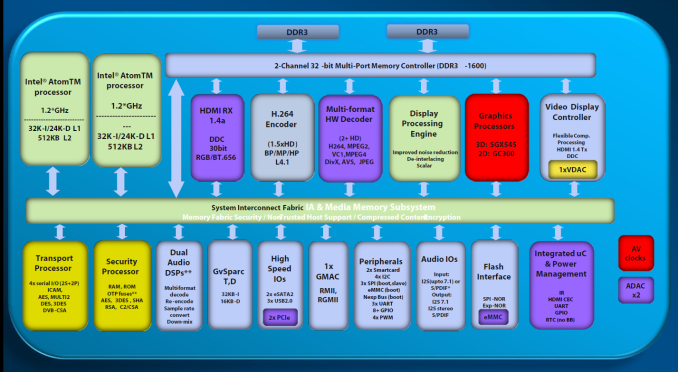Thecus N2560: Intel's EvanSport NAS Platform Review
by Ganesh T S on November 25, 2013 3:30 PM ESTIntel's EvanSport NAS Platform
Intel's recent foray into the consumer electronics (CE) space started with the 2007 launch of the Intel CE 2110 media processor. It was intended for digital set top boxes and media players / recorders. Based on a 1 GHz Intel XScale processor core, it had all the necessary integrated DSPs, GPUs, encryption engines and other I/Os. Around the same time, the Intel XScale business was sold to Marvell. Therefore, the follow-up Intel CE 3100 series for the same target market was based on a 800 MHz Intel Pentium M processor. The development of the Atom microarchitecture made it necessary to have yet another shift when it came to the Intel CE 4100. Fortunately, both Intel CE 4100 and the follow-up, CE 5300, are based around Atom cores. In an effort to branch out, the Intel CE 5300 series first debuted as a STB / media player platform (tagged Berryville in March 2012). A year later, it was also re-launched as a storage platform, EvanSport, for home users with media-centric usage patterns.
The CE5300 SoC ticks all the necessary I/O interfaces and features necessary for a media streaming platform. On the networked storage front, the blocks of interest are the high speed IOs, the GMAC and the security processor. We have one GbE interface. The typical x86 2-bay NAS usually comes with dual network ports (capable of port trunking), but units based on EvanSport are unlikely to have that. This is acceptable, considering that the unit is supposed to cater to home consumers who want to use it as a media server.
The other aspect of interest is the number of SATA and PCIe lanes. Two SATA ports point to most EvanSport designs ending up with two hard drive bays. As more and more data is generated by home consumers (thanks to smartphones which make it easier for users to shoot pictures and videos), two bays may not be sufficient moving forward (particularly when RAID protection is applied). NAS vendors may choose to use the two PCIe lanes along with a SATA bridge to provide two additional SATA ports on the board. Therefore, the maximum number of bays that we can hope to see with acceptable performance in a EvanSport-based NAS will be four.
The security processor is an interesting component. It contains an AES engine, but is primarily meant for handling DRM content in a STB environment. It should potentially be possible to use it to accelrate performance of encrypted volumes. However, it is up to the NAS vendors to take advantage of the feature.











73 Comments
View All Comments
JoannWDean - Saturday, December 14, 2013 - link
my buddy's aunt earned 14958 dollar past week. she been working on the laptop and got a 510900 dollar home. All she did was get blessed and put into action the information leaked on this site... http://cpl.pw/OKeIJoJEmlay - Monday, May 19, 2014 - link
No, I do not need more than 2 slots. 2 Drives, RAID0 with an external NTFS backup.xdrol - Monday, November 25, 2013 - link
Someone please enlighten me. Why does a NAS platform need a H.264 _encoder_?OzzieGT - Monday, November 25, 2013 - link
Transcode content into H.264 for devices which might not be able to read the native format.jwcalla - Tuesday, November 26, 2013 - link
Are there really devices out there that can't do H.264 Full HD?ganeshts - Tuesday, November 26, 2013 - link
Bandwidth constraints? You probably don't want a 1080p video streamed to your smartphone (which probably may not support the original H.264 profile) in full bit-rate. Transcoding to a smaller bitrate is often the reason why people use media servers.jwcalla - Tuesday, November 26, 2013 - link
Aren't we talking about like 10 Mb/s? What modern wifi couldn't handle that?ganeshts - Tuesday, November 26, 2013 - link
Blu-ray uncompressed MKVs can go up to 54 Mbps for non-3D titles. Couple this with multiple streams being played via different mobile devices simultaneously -- it still makes sense to transcode to a lower bitrate in situations (read, small screens) where the quality difference is not noticeable.jwcalla - Tuesday, November 26, 2013 - link
People are storing uncompressed Blu-ray on their two-bay NAS?ganeshts - Tuesday, November 26, 2013 - link
Why not? 4 TB + 4 TB in RAID-1 will get you a pretty big library, considering that the average Blu-ray size without the extras and stuff will probably be inbetween 20 - 30 GB.